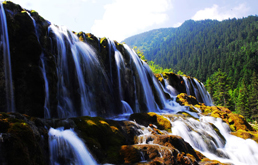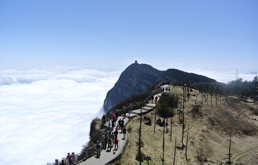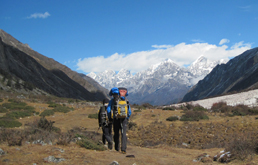Chengdu
Pandas' Hometown
Jiuzhaigou
Famous Fairyland
Emeishan
Sacred Buddhist Site
Leshan
Giant Buddha
Gonggashan
Best for Hiking
Daocheng Yading
Shangri La Views
Dujiangyan
Irrigation System
Siguniangshan
Eastern Alps
Baoguang Monastery is believed to be built in Eastern Han Dynasty about 1900 years ago. It is one of the four greatest monasteries within the Yangtze River Range. It is located 20km north to Chengdu. Baoguang Monastery is a big Buddhist Monastery with a complete system with different constructions. It is only about half an hour’s drive from Chengdu one shall reach Baoguang Monastery in Xindu District in the north. It covers a total of 8 hectares inside the condense area of Xindu. Entrance charge is 5 yuan.
The name of the monastery Baoguang came from the Tang Emperor Xizong when he fled from Chang’an to Chengdu during a rebellion at around 880AD. This monastery was used as Xizong’s residence. Baoguang means “precious light” or “sacred light”. It was believed that Xizong saw the sacred light on the top of the Baoguang pagoda.

From Chengdu to Baoguangsi is a direct bus from Wukuaishi Bus Station route number 651. Stars from 7:00 am to 7:00pm. It costs 5 yuan and within 1.5 hours. The other terminal is right in front of Baoguang Monastery. Another bus 650 from Liangjiaxiang Bus Station is another option. The 650 runs from Liangjiaxiang Bus Station from Xindu Bus Station, after arrive in Xindu, you’ll need to transfer to another local bus for example Route 666 or use a taxi or rickshaw.
There are plenty of the buses 651 and 650 running between Chengdu and Xindu everyday. It takes one hour to one hour and a half to get there. The bus ticket is within 5 yuan. Aside from buses, other ways of traveling there are limited.

This big complex was built with wood and stone. Over 400 pieces of stone pillars were used in the many temples. A pagoda, 5 temples, 16 constructions make to this red walled Buddhist shrine. On the central line lines (south to north) Stone screen (zhaobi), Maitreya Temple, Protectors Hall, Sarira Pagoda, Seven Buddha Temple, Library and Zixia Hill. Located by each side are Bell Tower, Drum Tower, Arhart Hall, Guesthouse, Canteen, Meditation Residence, etc. It is one of the representatives of ancient Chinese Buddhist monasteries.
The Sarira Pagoda is after the Protectors Hall. It was built during Xizong in Tang Dynasty over a thousand years from now. It is a 13-leveled, four faces pagoda with a height of around 20 meters. At every store on each side there are three statues of Buddha. Pictures carved on the stone at the bottom were from Buddhist master Taixu. A total of 140 statues of Buddha were stored in this pagoda. It has a copper top which Buddhists believe to be the source of the “sacred light”.
Seven Buddha Hall is located after the pagoda. It was built by Zhenyin in 1861. By the base of this temple there are two dragon carvings which are the only relics left from Xizong time. The buddhas include 3 to 4 meters’ tall Guangming Buddha, Duobao Buddha, Baosheng Buddha, Miaose Buddha, Guangbo Buddha, Libu Buddha, Amitabha Buddha. There is also a Jade sleeping Buddha in the front. It was a gift from Buddhist from Burma in 1991.
Built in Qing Dynasty, rebuilt several times after that, this temple was held up with 42 stone pillars. The statue of Sakyamuni is in the middle with his two disciples Kassapa Thera and Ananda by each side. There are two famous couplet by the front gate of the hall: ???????????????????????????????. A loose translation of this scroll is “No rule is the best rule; no solution is the best solution”.
The Meditation Hall is located at the east of the complex. It is 10 meters’ tall. The most significant item is a 5-meter tall stone stupa. It was made in Qing Dynasty out of a big stone. The making itself took three years by three different workers. There are Buddhist figures, dragons and flowers on the stupa. It is a holy temple used by Jingtuzong (Pure-Land School).
The Antique Hall of Baoguang Monastery is located by the west. An extra of 30 yuan is required to go in. The collection inside the hall are substantial includes a tablet carved in 540AD, a Beiye scrolls from King of Thailand in 1906, 4 Sariras from Sri-Lanka, paintings and calligraphies from famous Chinese artists Tangbohu, Zhuzhishan and Zhangdaqian.

The Arhart Hall was established in 1851. There are 518 statues of Arharts, 59 statues of Buddha and Bodhisattva. Two of the arharts statues are the Emperor of Kangxi and the Emperor of Qianlong. Every arhart statue is about 2 meters’ tall and each one is different in appearance. This arhart hall is largest dirt-made arhart hall in anywhere in China. And it is considered of the four greatest arhart halls in China. In the middle of the hall, there is a statue of Guanyin with 28 heads, 56 hands and 196 eyes. The origin of the 500 arharts is from India. It was said that at the beginning there was a monk who taught 500 royal students and the students became Buddhists later. Another story goes there were 500 business men traveling for treasure and was tortured by robbers and was saved by Sakyamuni.
Near the Baoguang Monastery there is a park called Guihu Park. It is composed of two parts the outer park and the inner park. The inner park is also a former residence of a famous local person Yangshengyan from Qing Dynasty. The inner park is also a museum with collections of fine paintings, calligraphies and other antiques. You will need to pay 20 yuan to visit. While the outer part is free. The outer park is mainly a big pond full of lotus and many teahouses.
Baoguang monastery is open all year round. It does not matter if you visit it in the morning or in the afternoon.
Opening hours: 08:00~18:00
recommended length of visiting: 2 hours

Route: Chengdu - Jiuzhaigou

Route: Chengdu - Leshan - Emeishan - Chengdu

Route: Chengdu - Kangding - Gongga - Chengdu